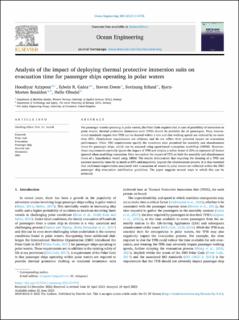| dc.contributor.author | Azizpour, Hooshyar | |
| dc.contributor.author | Galea, Edwin R. | |
| dc.contributor.author | Deere, Steven | |
| dc.contributor.author | Erland, Sveinung | |
| dc.contributor.author | Batalden, Bjørn-Morten | |
| dc.contributor.author | Oltedal, Helle Asgjerd | |
| dc.date.accessioned | 2023-08-23T12:07:56Z | |
| dc.date.available | 2023-08-23T12:07:56Z | |
| dc.date.created | 2023-06-29T10:26:59Z | |
| dc.date.issued | 2023 | |
| dc.identifier.citation | Ocean Engineering. 2023, 283 . | en_US |
| dc.identifier.issn | 0029-8018 | |
| dc.identifier.uri | https://hdl.handle.net/11250/3085458 | |
| dc.description.abstract | For passenger vessels operating in polar waters, the Polar Code requires that in case of possibility of immersion in polar waters, thermal protective immersion suits (TPIS) should be available for all passengers. Thus, international standards require that TPIS can be donned within 2 min and that walking speeds are reduced by no more than 25%. Clearlythese requirements are arbitrary and do not reflect their potential impact on evacuation performance. Other IMO requirements specify the maximum time permitted for assembly and abandonment times for passenger ships, which can be assessed using agent-based evacuation modelling (ABEM). However, these requirements currently ignore the impact of TPIS and employ a safety factor of 25% to represent all factors ignored when modelling evacuation. Here we explore the impact of TPIS on both the assembly and abandonment times of a hypothetical vessel using ABEM. The results demonstrate that requiring the donning of a TPIS can increase assembly times by as much as 65% and negatively impacts the abandonment process. It is thus essential that additional requirements associated with evacuation of vessels in polar waters are reflected within the IMO passenger ship evacuation certification guidelines. The paper suggests several ways in which this can be achieved. | en_US |
| dc.language.iso | eng | en_US |
| dc.publisher | Elsevier | en_US |
| dc.rights | Navngivelse 4.0 Internasjonal | * |
| dc.rights.uri | http://creativecommons.org/licenses/by/4.0/deed.no | * |
| dc.title | Analysis of the impact of deploying thermal protective immersion suits on evacuation time for passenger ships operating in polar waters | en_US |
| dc.type | Peer reviewed | en_US |
| dc.type | Journal article | en_US |
| dc.description.version | publishedVersion | en_US |
| dc.source.pagenumber | 15 | en_US |
| dc.source.volume | 283 | en_US |
| dc.source.journal | Ocean Engineering | en_US |
| dc.identifier.doi | 10.1016/j.oceaneng.2023.114725 | |
| dc.identifier.cristin | 2159338 | |
| dc.source.articlenumber | 114725 | en_US |
| cristin.ispublished | true | |
| cristin.fulltext | original | |
| cristin.qualitycode | 1 | |

